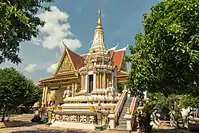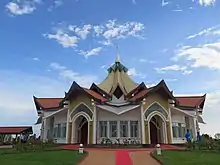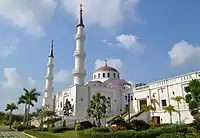Religion in Cambodia
Buddhism is the official religion of Cambodia. Approximately 98% of Cambodia's population follows Theravada Buddhism, with Islam, Christianity, and tribal animism making up the bulk of the small remainder.[1][2] The wat (Buddhist monastery) and Sangha (monkhood), together with essential Buddhist doctrines such as reincarnation and the accumulation of merit, are at the centre of religious life.
Religion in Cambodia (2013 World Factbook)[1]
According to The World Factbook in 2013, 97.9% of Cambodia's population was Buddhist, 1.1% Muslim, 0.5% Christian and 0.6% Other.[1]
According to the Pew Research Center in 2010, 96.9% of Cambodia's population was Buddhist, 2.0% Muslim, 0.4% Christian, and 0.7% folk religion and non religious.[3]
Buddhism

Buddhism has existed in Cambodia since at least the 5th century AD, with some sources placing its origin as early as the 3rd century BC. Theravada Buddhism has been the Cambodian state religion since the 13th century AD (excepting the Khmer Rouge period), and is currently estimated to be the religion of 97.9% of the total population.[4]
The history of Buddhism in Cambodia spans nearly two thousand years, across a number of successive kingdoms and empires. Buddhism entered Cambodia through two different streams. The earliest forms of Buddhism, along with Hindu influences, entered the Funan kingdom with Hindu merchants. In later history, a second stream of Buddhism entered Khmer culture during the Angkor empire when Cambodia absorbed the various Buddhist traditions of the Mon kingdoms of Dvaravati and Haripunchai.
For the first thousand years of Khmer history, Cambodia was ruled by a series of Hindu kings with an occasional Buddhist king, such as Jayavarman I of Funan, and Suryvarman I. A variety of Buddhist traditions co-existed peacefully throughout Cambodian lands, under the tolerant auspices of Hindu kings and the neighboring Mon-Theravada kingdoms. Angkor Wat, a Buddhist temple in Siem Reap, is the largest temple complex in the world.
Brahmanism (Hinduism)

Before Buddhism arrived, Cambodia was following Hinduism, during the beginning of the Kingdom of Funan. Hinduism was one of the Khmer Empire's main religions. Cambodia is the home to two biggest Hindu Temples dedicated to Brahma.
Islam
Muslim traders along the main trade-route between Western Asia through Āryāvarta were responsible for the introduction of Islam to Cambodia around 2nd to 17th centuries CE.[5] The religion was then further spread by the Chams and finally consolidated by the expansion of the territories of converted rulers and their communities. The Chams have their own mosques. In 1962 there were about 100 mosques in the country.
Christianity
The first known Christian mission in Cambodia was undertaken by Gaspar da Cruz, a Portuguese member of the Dominican Order, in 1555-1556. According to his own account, the enterprise was a complete failure; he found the country run by a "Bramene" king and "Bramene" officials, and discovered that "the Bramenes are the most difficult people to convert". He felt that no one would dare to convert without the King's permission, and left the country in disappointment, not having "baptized more than one gentile whom I left in the grave".[6]
Despite the French colonization in the 19th century, Christianity made little impact in the country. In 1972 there were probably about 20,000 Christians in Cambodia, most of whom were Roman Catholics. Before the repatriation of the Vietnamese in 1970 and 1971, possibly as many as 62,000 Christians lived in Cambodia. According to Vatican statistics, in 1953, members of the Roman Catholic Church in Cambodia numbered 120,000, making it at the time, the second largest religion; estimates indicate that about 50,000 Catholics were Vietnamese. Many of the Catholics remaining in Cambodia in 1972 were Europeans – chiefly French; and still, among Catholic Cambodians are whites and Eurasians of French descent. Steinberg reported, also in 1953, that an American Unitarian mission maintained a teacher-training school in Phnom Penh, and Baptist missions functioned in Battambang and Siem Reap provinces. A Christian and Missionary Alliance mission was founded in Cambodia in 1923; by 1962 the mission had converted about 2,000 people.
American Protestant missionary activity increased in Cambodia, especially among some of the hill tribes and among the Cham, after the establishment of the Khmer Republic. The 1962 census, which reported 2,000 Protestants in Cambodia, remains the most recent statistic for the group. In 1982 French geographer Jean Delvert reported that three Christian villages existed in Cambodia, but he gave no indication of the size, location, or type of any of them. Observers reported that in 1980 there were more registered Khmer Christians among the refugees in camps in Thailand than in all of Cambodia before 1970. Kiernan notes that, until June 1980, five weekly Protestant services were held in Phnom Penh by a Khmer pastor, but that they had been reduced to a weekly service after police harassment. His estimates suggest that in 1987 the Christian community in Cambodia had shrunk to only a few thousand members.[7]
Various Protestant denominations have reported marked growth since the 1990s, and by some current estimates Christians make up 2-3% of Cambodia's population.[8][9]
There are around 75,000 Catholics in Cambodia which represents 0.5% of the total population.[10] There are no dioceses, but there are three territorial jurisdictions - one Apostolic Vicariate and two Apostolic Prefectures. The Church of Jesus Christ of Latter-day Saints (also known as the Mormons) has a growing population in Cambodia. The church's president, Gordon B. Hinckley, officially introduced missionary work to Cambodia on May 29, 1996.[11] The church now has 31 congregations (27 Khmer language and three Vietnamese language, and one international). Jehovah’s Witnesses are present in Cambodia since 1990 and opened their third Kingdom Hall in 2015.[12]
Baháʼí Faith

The introduction of the Baháʼí Faith in Cambodia first occurred in 1920, with the arrival of Hippolyte Dreyfus-Barney in Phnom Penh at the behest of 'Abdu'l-Bahá.[13] After sporadic visits from travelling teachers throughout the first half of the 20th century, the first Baháʼí group in Cambodia was established in that city in 1956.[14][15] By 1963, Baháʼís were known to reside in Phnom Penh, Battambang, Siem Reap and Sihanoukville, with a functioning Spiritual Assembly present in Phnom Penh.[16]
During the rule of the Khmer Rouge in the late 1970s, the Baháʼís of Cambodia became isolated from the outside world.[17] Many of them joined with the flood of refugees that dispersed around the world following the fall of the Khmer Rouge, resettling in places such as Canada and the United States, where special efforts were made to contact them and incorporate them into local Baháʼí community life.[18] Baháʼís in Thailand and other countries reached out to the Cambodian refugees living in camps on the Thai-Cambodian border; this eventually led to the growth of Baháʼí communities there, including the establishment of Spiritual Assemblies.[19][20]
The Baháʼí community has recently seen a return to growth, especially in the city of Battambang. The city hosted one of 41 Baháʼí regional conferences worldwide in 2009, which attracted over 2,000 participants.[21] Two regional youth conferences occurred in Cambodia in 2013, including one in Battambang and one in Kampong Thom.[22][23] In 2012, the Universal House of Justice announced plans to establish a local Baháʼí House of Worship in Battambang.[24] Its design was unveiled in July 2015,[25] with the groundbreaking following in November.[26] The House of Worship—the first Bahá'í House of Worship to serve a single locality—was dedicated in a ceremony in September 2017, attended by 2,500 people.[27]
According to a 2010 estimate, Cambodia is home to approximately 16,700 Baháʼís.[28]
Indigenous beliefs
Highland tribal groups, most with their own local religious systems, include approximately 150,000 people.[29] The Khmer Loeu have been loosely described as animists, but most indigenous ethnic groups have their own pantheon of local spirits. In general they see their world filled with various invisible spirits (often called yang), some benevolent, others malevolent. They associate spirits with rice, soil, water, fire, stones, paths, and so forth. Shamans, sorcerers or specialists in each village contact these spirits and prescribe ways to appease them. In times of crisis or change, animal sacrifices may be made to placate the anger of the spirits. Illness is often believed to be caused by evil spirits or sorcerers. Some tribes have special medicine men or shamans who treat the sick. In addition to belief in spirits, villagers believe in taboos on many objects or practices. Among the Khmer Loeu, the Austronesian groups (Rhade and Jarai) have a well-developed hierarchy of spirits with a supreme ruler at its head.[7]
In recent years, the label “Brahmanism” has been used (with only a vague reference to Hinduism) to indicate the rise after 1979 of a large network of spirit mediums who propose to their clients prosperity rituals grounded in folk religion, criticized by some Buddhists as heterodox and foreign to Buddhism. Others regard “Brahmanism” and Buddhism as “two branches of one religious system that they call ‘Cambodian Buddhism,’” and occasionally Buddhist monks attend “Brahmanist” rituals. Increasingly, however, “Cambodians differentiate clearly between Brahmanism and Buddhism,” and regards “Brahmanism” as non-Buddhist.[30]
| Part of a series on the |
| Culture of Cambodia |
|---|
 |
| History |
| People |
| Languages |
| Cuisine |
| Religion |
| Literature |
| Sport |
|
Judaism
There is a small Jewish community in Cambodia consisting of a little over 100 people. Since 2009, there has been a Chabad house in Phnom Penh.[31]
References
- The World Factbook
- "Religious Composition by Country" (PDF). Global Relidious Landscape 2010. Pew Research Center. Archived from the original (PDF) on March 10, 2016. Retrieved 25 August 2019.
- "Religious Composition by Country" (PDF). Global Relidious Landscape 2010. Pew Research Center. Archived from the original (PDF) on March 10, 2016. Retrieved 25 August 2019.
- "CIA World Factbook - Cambodia". Retrieved 2007-04-10.
- "Culture And Heritage - Medieval History - The Rise Of Islam In South Asia - Know India: National Portal of India". knowindia.gov.in. Retrieved 2020-10-18.
- Boxer, Charles Ralph; Pereira, Galeote; Cruz, Gaspar da; Rada, Martín de (1953), South China in the sixteenth century: being the narratives of Galeote Pereira, Fr. Gaspar da Cruz, O.P. (and) Fr. Martín de Rada, O.E.S.A. (1550-1575), Issue 106 of Works issued by the Hakluyt Society, Printed for the Hakluyt Society, pp. lix, 59–63
- Federal Research Division. Russell R. Ross, ed. "Other religions". Cambodia: A Country Study. Research completed December 1987. This article incorporates text from this source, which is in the public domain.
- Encyclopedia Britannica https://www.britannica.com/place/Cambodia/Religion. Accessed 5 November 2017.
- Operation World, Seventh Ed. Jason Mandryk, 2010
- Ford, Peter (14 March 2017). "Cambodia, Catholicism, and Cauliflower". The Diplomat. Kien Svay District, Cambodia: Diplomat Media Inc. Retrieved 10 April 2020.
- Leland D. and Joyce B. White, [www.lds.org/liahona/1997/10/the-gospel-takes-hold-in-cambodia "The Gospel Takes Hold in Cambodia"], Liahona, October 1997, p. 41.
- Naomi-Collett Ritz, “Jehovah’s Witnesses Open Kingdom Hall Near Angkor Wat,” Khmer Times, March 3, 2015.
- "Hippolyte Dreyfus, apôtre d'Abdu'l-Bahá" [Hippolyte Dreyfus, Disciple of 'Abdu'l-Bahá]. National Spiritual Assembly of the Baháʼís of France. 2000. Retrieved 2012-09-24.
- Messages of Shoghi Effendi to the Indian Subcontinent: 1923-1957. Baháʼí Publishing Trust of India. 1995. p. 403.
- "Teaching and Assembly Development Conference for Vietnam, Cambodia, Laos and Thailand". Baháʼí News Letter. National Spiritual Assembly of the Baháʼís of India, Pakistan & Burma (85). 1956.
- http://bahai-library.com/handscause_statistics_1953-63
- http://bahai-library.com/hassall_religious_freedom_asia-pacific
- http://bahai-library.com/uhj_bahai_world_18. p.131
- http://bahai-library.com/uhj_bahai_world_18 p.96
- The Universal House of Justice. Century of Light. p.104. http://reference.bahai.org/en/t/bic/COL/col-11.html
- http://news.bahai.org/community-news/regional-conferences/battambang.html
- Battambang Youth Conference. Baháʼí International Community.
- Kampong Thom Youth Conference. Baháʼí International Community.
- http://news.bahai.org/story/906
- http://news.bahai.org/story/1062/
- http://news.bahai.org/story/1082/
- http://news.bahai.org/story/1190/
- "QuickLists: Most Baha'i (sic) Nations (2010)". Association of Religion Data Archives. 2010. Retrieved 2020-10-14.
- 1996 estimate
- Paul Christensen, “We Will Never Get Rich If We Follow Buddhism”: The Rise of Brahmanism in Cambodia, Göttingen: GISCA Occasional Papers, Göttingen Institute for Social and Cultural Anthropology, 2019, 5.
- Ellen, Rosa (December 14, 2012). "Festival of light shines in Phnom Penh". The Phnom Penh Post. Retrieved December 25, 2012.
